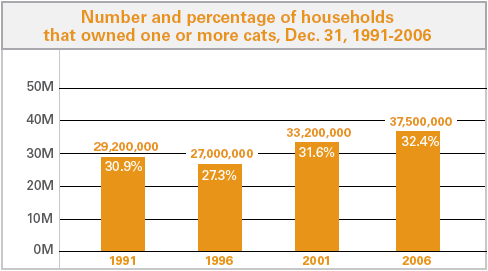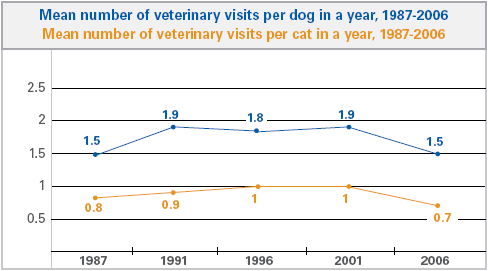Human-animal bond boosts spending on veterinary care
Most people consider their pets to be family members or companions, not property, and spending on veterinary care has increased. Yet, veterinary visits per pet have declined, and cats are not receiving the same care as dogs.

These trends are apparent from data in the 2007 U.S. Pet Ownership and Demographics Sourcebook, which the AVMA recently released. The book draws on a 2006 survey of almost 50,000 households and on data from previous editions of the book, which the AVMA has produced approximately every five years for more than 25 years.
For love of pets
The statistics reveal that almost all pet owners feel a strong human-animal bond. About 49.7 percent consider pets to be family, and 48.2 percent consider pets to be companions. The remaining 2.1 percent consider pets to be property.
Dr. Gregory S. Hammer, AVMA president, said he has observed the growth of the human-animal bond. Not too long ago, he said, dogs lived in the yard and cats lived in the barn.
"When I first started in practice, 30 years ago, it wasn't unusual at all for the dog that belonged to the family to never set foot in the house," he said. "Now, I don't know what percentage of dogs sleep with their owners, but it's awfully high."
Dr. Hammer said people also have welcomed cats into the home more than ever.
For cat and dog owners, the survey found that the human-animal bond has a close association with mean number of veterinary visits and total spending on veterinary care. Households that consider dogs to be family averaged three veterinary visits in 2006, for example, in comparison with 2.2 visits for households that consider dogs to be pets or companions and 1.1 visits for households that consider dogs to be property.
Ownership of cats and dogs has increased during the past decade, not only in numbers of households but also in percentages of households. More households owned dogs than cats in 2006, but cat-owning households owned an average of 2.2 cats while dog-owning households owned an average of 1.7 dogs. The total population was 81.7 million pet cats and 72 million pet dogs.
"I think it's good news for the veterinary profession and our society that the number of U.S. households owning pets grew," said Dr. Lawrence E. Heider, interim chief executive officer of the National Commission on Veterinary Economic Issues.
Spending on veterinary care
The rise in spending on veterinary care also may be good news for the profession, as the costs of veterinary education and modern medicine continue to climb. Dr. Heider said people who consider pets to be family demand the highest quality of care, so he sees a relationship between the growth of the human-animal bond and increasing costs for modern veterinary care.
"I think they're hand and glove—and synergistic—creating the situation where people are willing and needing to spend more money," Dr. Heider said.
Much of the rise in spending may come from pet owners choosing to pay for major services rather than the changes in the price of routine procedures. Dog-owning households that spent $1,000 or more in a year, for example, jumped from 2.2 percent in 1996 to 8.4 percent in 2006.
"Overall spending on veterinary care is up significantly," said Jim Flanigan, AVMA marketing director and coordinator of the sourcebook. "Most of that rise in spending is coming from dogs."
Veterinary spending per cat has hardly changed in the past decade, even as people continue to own more cats than dogs. Flanigan noted that the percentage of pets receiving no veterinary care had been trending downward but now has risen again, feeding the fears of some that veterinarians have priced themselves out of the market.


Nevertheless, Flanigan said, AVMA research has not found evidence of price sensitivity among most pet owners. He said the human-animal bond is a stronger indicator of spending than household income is.
"This study is not at all about what veterinarians are charging," Flanigan said. "This study is about what people are spending."
Flanigan said overall demand for veterinary care is increasing, as is demand for the highest quality care.
Veterinary visits
On average, dogs and cats are visiting veterinarians less frequently.
"I find that a bit disturbing," said Dr. Thomas A. Carpenter, president of the American Animal Hospital Association. Dr. Carpenter said AAHA actually has recommended twice-a-year visits rather than annual visits to promote wellness.
Dogs averaged 1.5 visits in 2006, down from 1.9 visits in 2001. Cats averaged 0.7 visits in 2006, down from one visit on average in 2001. Only 63.7 percent of cat-owning households had at least one veterinary visit in 2006.
Dr. Hammer attributed the drop in visits partially to the transition in progress at many clinics from annual vaccinations to a three-year protocol.
"People routinely thought they had to get a vaccine every year and just forgot that the health check is the most important part of the visit," Dr. Hammer said.
Drs. Hammer and Heider said people might not see the necessity of bringing in their pets for preventive care, since dogs and cats are healthier these days—thanks to living indoors plus improvements in nutrition, medicine, and preventive care.
In 2001, physical examinations passed vaccinations as the top service or product that dog-owning households requested at the most recent veterinary visit. The same happened with cat-owning households in 2006. Purchases of drugs from the pet owner's veterinary clinic have declined steadily in recent years, with many veterinarians attributing the drop to use of Internet pharmacies.
The percentage of dog-owning and cat-owning households that reported no veterinary expenditures increased in the past decade, from 17.4 percent to 20.9 percent for dog owners and from 33.2 percent to 39.2 percent for cat owners.
Dr. Heider said trends in U.S. incomes may mean that more pet owners cannot afford veterinary care, a cause for concern. Dr. Hammer noted that people do have a choice whether to own pets, though, and they ideally should project expenses.
The cat conundrum
While the number of cat-owning households has increased, the number of veterinary visits by cat-owning households fell from 70.8 million in 2001 to 63.3 million in 2006.
"It is a call to action," said Dr. Valerie Creighton, president of the American Association of Feline Practitioners. "I think, as a profession, we have to make sure that cats' medical needs are adequately addressed."
Dr. Creighton doesn't know why cats are visiting veterinarians less frequently, but she noted the disparity between cats and dogs in veterinary care. Veterinary visits and spending are highest for dogs in dog-only households—followed by dogs in households with a cat or cats, cats in cat-only households, and cats in households with a dog or dogs. Dr. Creighton said the AAFP would very much like to shift that paradigm.
The three-year vaccine schedule may contribute to the decline in veterinary visits for cats, Dr. Creighton said. On the other hand, she said, moving away from vaccination as the sole trigger for a visit frees veterinarians to focus on the merits of the wellness visit for disease prevention and early intervention.
The status of feline health care will be the subject of a summit by the AAFP and Pfizer Animal Health in early February, in conjunction with the AAFP winter meeting in Palm Springs, Calif. Dr. Creighton said the CATalyst Summit will examine the trends and develop strategies to address them. Invitees will include leaders from veterinary associations, industry, academia, and humane organizations.
"Our goal for its outcome would be a strategic alliance and a joint initiative among these key players aimed at enhancing the level of medical care delivered to cats," Dr. Creighton said.
The statistics confirming that cats visit veterinarians much less often than dogs do also were striking to Dr. Carpenter of AAHA.
"Improving that frequency would lead to overall increased longevity and health for cats," Dr. Carpenter said.
He said the longevity of pets has increased in general, but the potential exists for further improvement. The percentage of dogs that are 6 years or older increased only moderately between 1987 and 2006. Despite the less frequent veterinary visits, the percentage of cats 6 or older jumped from 28.5 percent to 44.1 percent during that period.
Beyond cats and dogs
Cats and dogs are not the only species in the sourcebook. The survey asked pet owners about birds, horses, and specialty and exotic pets. The survey also examined owner demographics.
Owner demographics have remained fairly consistent over the years, though more people now own pets overall. Pet owners are more likely than people who don't own pets to be married, have children, live in a household with two or more members, work full time, have a higher household income, own a home, and live in a smaller community.


Between 2001 and 2006, the largest growth rate in pet ownership was among retired couples. Black/African-American households were less likely to own pets in 2006 than households of other racial and ethnic groups.
The sections of the sourcebook on birds, horses, and specialty and exotic pets reveal that fewer households owned pet birds in 2006 than in 2001—but more households owned "pet horses." The population of pet fish rose from 49.3 million to 75.9 million, while pet turtles have increased from 1.1 million to 2 million.
Horse and bird owners, like cat and dog owners, feel a bond with their animals. About 38.4 percent of horse owners consider their horses to be family, and 56.5 percent consider horses to be pets or companions. About 51.3 percent of bird owners consider their birds to be family, and 46.9 percent consider birds to be pets or companions.
See page 41 for information about ordering the 2007 U.S. Pet Ownership and Demographics Sourcebook.
Correction: An earlier version of this article inaccurately described the sample for the 2006 survey on pet ownership and demographics. The survey was of almost 50,000 households, not almost 50,000 pet owners.